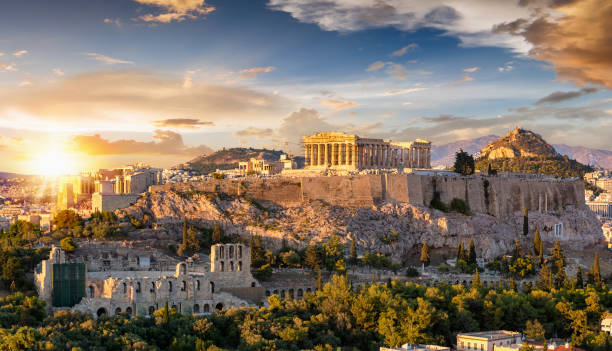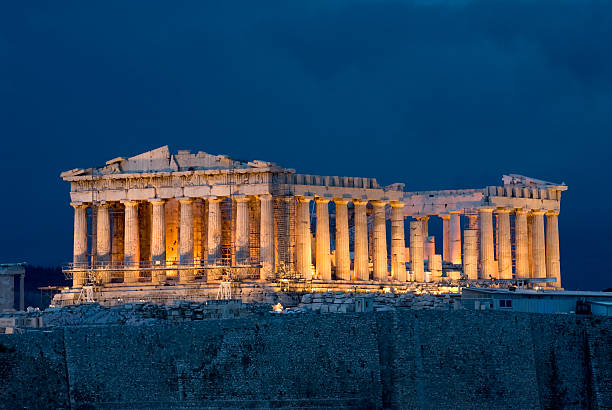The Acropolis of Athens, Greece: A Timeless Monument of Civilization
Perched high upon a rocky limestone hill above the sprawling modern city of Athens, the Acropolis of Athens stands as one of the most iconic and enduring symbols of ancient civilization. A beacon of classical beauty, philosophical thought, and architectural innovation, the Acropolis is not merely a cluster of ancient ruins but a living testament to the intellectual and artistic brilliance of the 5th century BCE. It is a monument to the ambitions of a society that gave birth to democracy, drama, philosophy, and many of the cornerstones of Western culture.

Though the Acropolis hosts many structures, it is best known for the Parthenon—a majestic temple dedicated to the goddess Athena, the city’s patron deity. However, the Acropolis is much more than just one building. It is an extraordinary ensemble of classical structures, each reflecting the extraordinary craftsmanship and cultural richness of Athens during its Golden Age. This ancient citadel, continuously inhabited since the Neolithic period, embodies a complex narrative of war, politics, religion, and artistic achievement, rising through the ashes of history to become a UNESCO World Heritage Site and a symbol of Greece’s national identity.
The Origins: From Prehistory to Mycenaean Civilization
The history of the Acropolis stretches back thousands of years. The name “Acropolis” derives from the Greek words “akron” (highest point) and “polis” (city), effectively meaning the “high city.” Archaeological evidence shows that the Acropolis was inhabited as far back as the Neolithic period (around 4000 BCE), initially serving as a defensible hilltop settlement.
During the Mycenaean period (1600–1100 BCE), the Acropolis became a fortified palace complex, complete with megarons, walls, and administrative buildings. The famous Cyclopean walls, composed of massive limestone blocks, were built during this time and parts of them remain visible today. These walls gave the Acropolis an aura of invincibility and underscored its importance as a seat of power.
Following the decline of the Mycenaean civilization, the Acropolis entered a quieter phase, but it would rise again—this time as a spiritual and cultural center rather than a military one.

The Archaic Period: Temples and Artistic Emergence
The 7th and 6th centuries BCE marked the Acropolis's transformation into a sacred sanctuary. Temples and shrines were erected in honor of deities such as Athena and Poseidon. Among the earliest significant temples was the Hekatompedon, an early precursor to the Parthenon. During this period, the Athenians began commissioning large-scale sculptures and artworks, many of which were used to decorate the temples and altars on the Acropolis.
However, much of this early work was destroyed during the Persian invasion of 480 BCE, when King Xerxes I sacked Athens and reduced many of its sacred monuments to rubble. In the aftermath of this devastation, the Athenians vowed never to rebuild the temples destroyed by the Persians—a vow that remained until the era of Pericles, decades later.
The Golden Age of Athens: Pericles and the Classical Acropolis
The true glory of the Acropolis emerged in the mid-5th century BCE under the leadership of the statesman Pericles. Following the Persian Wars, Athens grew into a naval power and a cultural beacon of the ancient world. Pericles spearheaded an ambitious building program to restore and glorify the Acropolis, using the Delian League's treasury to fund his vision. His era ushered in the construction of the classical masterpieces we associate with the Acropolis today.
The Parthenon
The crown jewel of the Acropolis, the Parthenon was designed by architects Iktinos and Kallikrates and adorned by the sculptor Phidias. Construction began in 447 BCE and was completed in 438 BCE. Dedicated to Athena Parthenos ("Athena the Virgin"), the temple is a sublime example of Doric architecture with subtle refinements that reveal a mastery of optical illusion. For instance, the columns are slightly curved and the floor slightly convex to counteract visual distortion and make the temple appear perfectly straight.
Inside the Parthenon once stood a massive chryselephantine (gold and ivory) statue of Athena by Phidias, measuring over 12 meters in height. The temple’s metopes and friezes depicted scenes of Greek mythology, including the Panathenaic Procession, the battle between Lapiths and Centaurs, and the Gigantomachy—symbolic representations of the triumph of order over chaos.
The Erechtheion
To the north of the Parthenon lies the Erechtheion, a complex and highly unusual temple built between 421 and 406 BCE. It was constructed on uneven terrain to accommodate sacred sites and altars to various gods and legendary kings. The temple is best known for the Porch of the Caryatids, where six elegantly carved female figures serve as architectural supports in place of traditional columns.
The Erechtheion housed several religious relics, including the olive tree gifted by Athena, the saltwater spring created by Poseidon, and the tomb of Erechtheus, an ancient king of Athens. It functioned as a multi-purpose shrine that reflected the religious syncretism of classical Athens.
The Propylaea
The monumental entrance to the Acropolis is the Propylaea, designed by the architect Mnesikles. Constructed between 437 and 432 BCE, it was intended as a grand gateway, harmonizing the natural terrain with a symmetrical layout. Though never fully completed due to the Peloponnesian War, the Propylaea remains an architectural masterpiece, blending Doric and Ionic elements with strategic use of space and light.
The Temple of Athena Nike
A small Ionic temple perched on a bastion at the southwest corner of the Acropolis, the Temple of Athena Nike was completed around 427 BCE. It celebrated Athena as the goddess of victory and commemorated Greek victories over the Persians. The temple’s frieze is notable for its detailed and graceful depiction of battle scenes and mythological themes.
The Acropolis as a Cultural and Civic Symbol
The Acropolis of the classical period was not merely a religious site—it was a symbol of Athenian identity, pride, and cultural superiority. The architectural harmony, artistic excellence, and innovative engineering of its monuments exemplified the ideals of balance, rationality, and humanism that characterized the Golden Age of Athens.
The Acropolis was also the setting for major religious festivals, most notably the Panathenaia, which honored Athena with processions, sacrifices, and athletic contests. The Parthenon served both as a treasury and a temple, further tying it to the civic life of the city.
The Acropolis Through the Ages: Transformation and Survival
Following the classical period, the Acropolis experienced various phases of transformation. During the Hellenistic and Roman periods, it retained its sacred status but saw fewer monumental additions. The Roman emperors, including Hadrian, honored it with repairs and additions, helping to preserve its prestige.
With the rise of Christianity in the late Roman Empire, the temples of the Acropolis were converted into churches. The Parthenon became a Christian cathedral dedicated to the Virgin Mary. This adaptation helped preserve the structures, though many sculptures were damaged or removed.
During the Ottoman occupation of Greece, the Acropolis underwent another transformation. The Parthenon was converted into a mosque, complete with a minaret. Tragically, in 1687, during a conflict between the Venetians and Ottomans, a Venetian cannonball hit the Parthenon, which was being used as a gunpowder magazine by the Ottomans. The explosion caused massive destruction, reducing much of the central structure to ruins.

The 19th Century: Rediscovery and Plunder
As European fascination with antiquity grew during the 18th and 19th centuries, the Acropolis became a focus of archaeological and imperial interest. In the early 1800s, Lord Elgin, the British ambassador to the Ottoman Empire, removed a significant portion of the Parthenon’s sculptures, including metopes, frieze panels, and statues. These "Elgin Marbles" were later sold to the British Museum, where they remain a point of cultural and diplomatic controversy to this day.
After the Greek War of Independence, the Acropolis came under the control of the newly formed Greek state. Efforts began to remove Ottoman additions and to restore the site to its classical glory. The Acropolis, long a battleground and a house of worship, was reimagined as a national and cultural monument.
Modern Restoration and Conservation Efforts
The 20th and 21st centuries have seen major conservation efforts aimed at stabilizing, restoring, and preserving the Acropolis. The Acropolis Restoration Project, initiated in the 1970s and continuing today, has involved extensive research, careful dismantling and rebuilding of damaged structures, and the use of both original and new marble from the ancient quarry of Mount Pentelicus.
Advanced technologies, including 3D scanning and computer modeling, are being used to guide restorations. Special care has been taken to ensure that any new materials are distinguishable from the original but blend seamlessly to maintain visual integrity.
One of the most significant challenges has been pollution and acid rain, which have eroded marble surfaces. As a result, many original sculptures have been moved to the nearby Acropolis Museum, which opened in 2009 and offers climate-controlled protection and stunning displays of the artifacts in context.
The Acropolis Museum
The Acropolis Museum, located at the foot of the hill, is a modern architectural marvel designed to house every artifact found on the rock and surrounding slopes. Its most famous feature is the Parthenon Gallery, where the surviving Parthenon frieze is displayed in the same arrangement as it once adorned the temple.
This museum plays a vital role in the international campaign for the return of the Parthenon Marbles from the British Museum. Greece maintains that the sculptures were taken unlawfully and should be reunited with the remaining pieces in their rightful context.
The Acropolis Today: Symbolism and Global Heritage
The Acropolis of Athens is more than a physical site—it is a cultural and philosophical symbol. It represents the height of human achievement, the birth of democratic ideals, and the pursuit of beauty, reason, and civic virtue. Its survival through millennia of war, conquest, and environmental decay underscores its resilience and universal significance.
Each year, millions of visitors from around the world climb the sacred rock to witness the grandeur of the Parthenon and the elegance of the Erechtheion. School children study it as the cradle of Western civilization, and it continues to inspire artists, architects, philosophers, and statesmen.
In 1987, the Acropolis was designated a UNESCO World Heritage Site, recognized for its exceptional universal value. UNESCO describes it as “a symbol of the classical spirit and civilization” and emphasizes its influence on architecture and culture worldwide.
Conclusion: A Living Legacy
The Acropolis of Athens endures as one of the greatest cultural landmarks in human history. It tells the story of a city that dared to explore new political ideas, artistic frontiers, and philosophical questions. Its temples may now be ruins, but their spirit remains vibrantly alive—in the columns that still rise proudly against the sky, in the marble statues whose features echo human ideals, and in the philosophical legacy that still shapes global thought.
Whether seen as a sacred precinct, a political symbol, or an architectural marvel, the Acropolis speaks to something deep and enduring in the human soul. It invites each generation to ascend its paths, reflect upon its stones, and connect with a past that continues to shape the future.
Photo from: Pixabay, iStock
0 Comment to "The Acropolis of Athens,Greece: Timeless Monument of Civilization and the Pinnacle of Ancient Greek Achievement"
Post a Comment